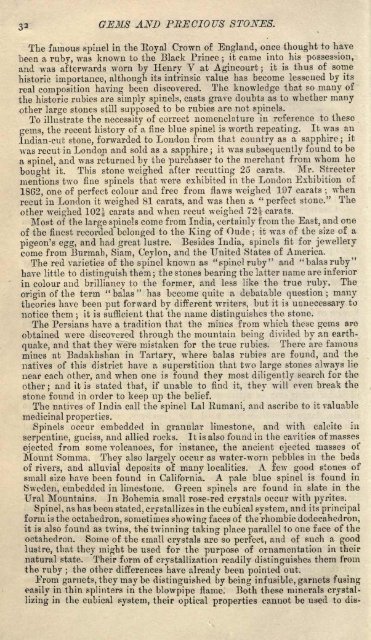UC-NRLF B 14
UC-NRLF B 14
UC-NRLF B 14
You also want an ePaper? Increase the reach of your titles
YUMPU automatically turns print PDFs into web optimized ePapers that Google loves.
3 2 GEMS AND PRECIOUS STONES.<br />
The famous spinel in the Royal Crown of England, once thought to have<br />
been a ruby, was known to the Black Prince ; it came into his possession,<br />
and was afterwards worn by Henry V at Agincourt; it is thus of some<br />
historic importance, although its intrinsic value has become lessened by its<br />
real composition having been discovered. The knowledge that so many of<br />
the historic rubies are simply spinels, casts grave doubts as to whether many<br />
other large stones still supposed to be rubies are not spinels.<br />
To illustrate the necessity of correct nomenclature in reference to these<br />
gems, the recent history of a fine blue spinel is worth repeating.<br />
It was an<br />
Indian-cut stone, forwarded to London from that country as a sapphire ; it<br />
was recut in London and sold as a sapphire found to be<br />
;<br />
it was subsequently<br />
a spinel, and was returned by the purchaser to the merchant from whom he<br />
bought it. This stone weighed after recutting 25 carats. Mr. Streeter<br />
mentions two fine spinels that were exhibited in the London Exhibition of<br />
1862, one of perfect colour and free from flaws weighed 197 carats ; when<br />
recut in London it weighed 81 carats, and was then a "perfect stone." The<br />
other weighed 102| carats and when recut weighed 721 carats.<br />
Most of the large spinels come from India, certainly from the East, and one<br />
of Oude it was of the size of a<br />
of the finest recorded belonged to the King ;<br />
pigeon's egg, and had great lustre. Besides India, spinels fit for jewellery<br />
come from Burmah, Siam, Ceylon, and the United States of America.<br />
The red varieties of the spinel known as "spinel ruby" and "balas ruby"<br />
the stones bearing the latter name are inferior<br />
have little to distinguish them ;<br />
in colour and brilliancy to the former, and less like the true ruby. The<br />
origin of the term " balas " has become quite a debatable question ; many<br />
theories have been put forward by different writers, but it is unnecessary to<br />
notice them it is sufficient that the name ; distinguishes the stone.<br />
The Persians have a tradition that the mines from which these gems are<br />
obtained were discovered through the mountain being divided by an earthquake,<br />
and that they were mistaken for the true rubies. There are famous<br />
mines at Badakhshan in Tartary, where balas rubies are found, and the<br />
natives of this district have a superstition that two large stones always lie<br />
near each other, and when one is found they most diligently search for the<br />
other ; and it is stated that, if unable to find it, they will even break the<br />
stone found in order to keep up the belief.<br />
The natives of India call the spinel Lai Eumani, and ascribe to it valuable<br />
medicinal properties.<br />
Spinels occur embedded in granular limestone, and with calcite in<br />
serpentine, gneiss, and allied rocks. It is also found in the cavities of masses<br />
ejected from some volcanoes, for instance, the ancient ejected masses of<br />
Mount Somma. They also largely occur as water-worn pebbles in the beds<br />
of rivers, and alluvial deposits of many localities. A few good stones of<br />
small size have been found in California. A pale blue spinel is found in<br />
Sweden, embedded in limestone. Green spinels are found in slate in the<br />
Ural Mountains. Jn Bohemia small rose-red crystals occur with pyrites.<br />
Spinel, as has been stated, crystallizes in the cubical system, and its principal<br />
form is the octahedron, sometimes showing faces of the rhombic dodecahedron,<br />
it is also found as twins, the twinning taking place parallel<br />
to one face of the<br />
octahedron. Some of the email crystals are so perfect, and of such a good<br />
lustre, that they might be used for the purpose of ornamentation in their<br />
natural state. Their form of crystallization readily distinguishes them from<br />
the ruby the other differences ;<br />
have already been pointed out.<br />
Erom garnets, they may be distinguished by being infusible, garnets fusing<br />
easily in thin splinters in the blowpipe flame. Both these minerals crystallizing<br />
in the cubical system, their optical properties cannot be used to dis-

















